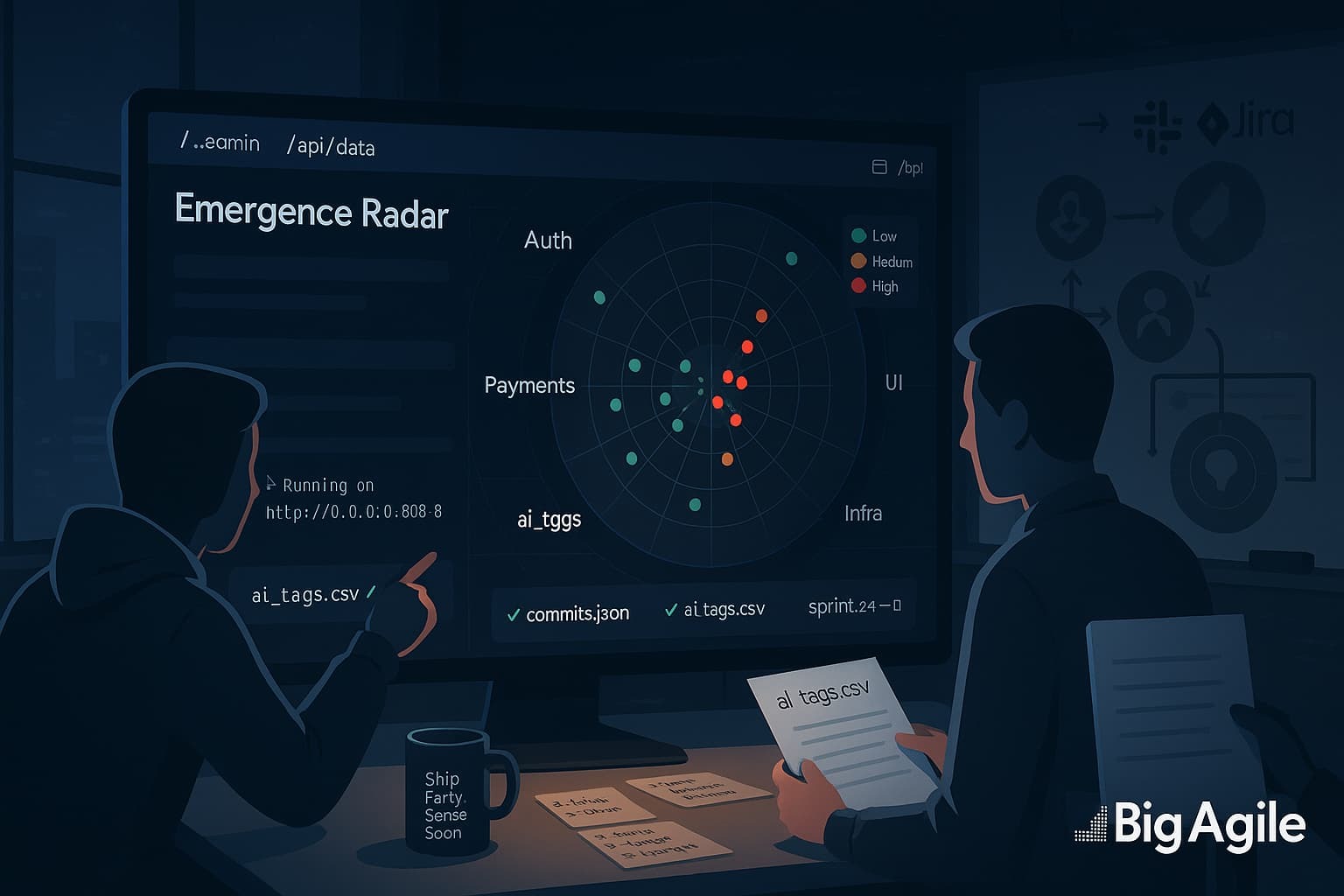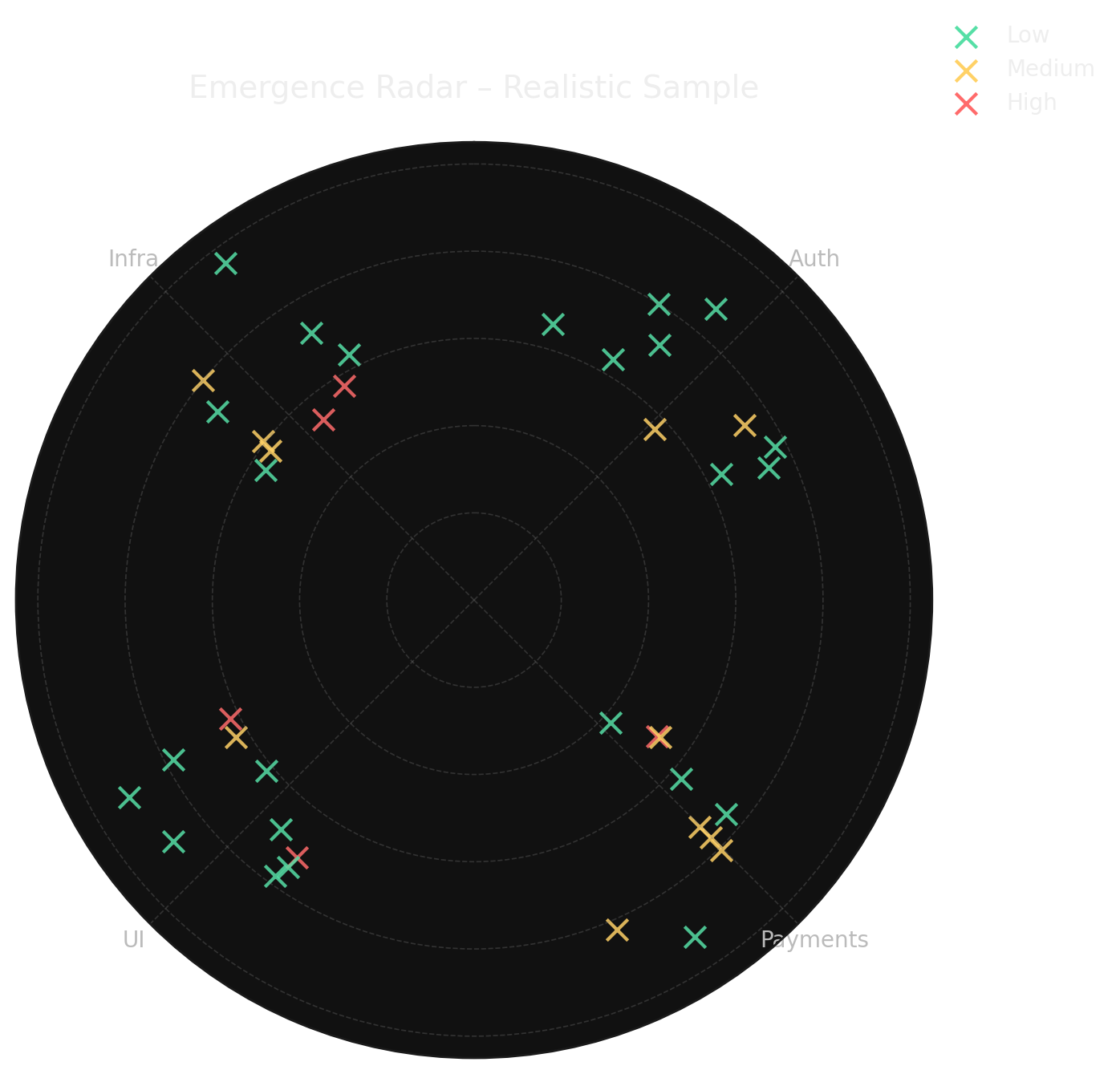
The Problem.
Your team runs on ceremonies and dashboards, but between stand-ups and sprint reviews, blind spots can lurk. Commit spikes hide stealth debt, sentiment dips signal brewing burnout, and WIP peaks quietly slow flow. By the time a burndown turns red or Slack buzzes with frustration, you’re firefighting rather than building value. Here is where we can really help our team with tools to visualize our work.
The Agility.
Business agility isn’t about rigid rituals; it’s about emergent awareness, noticing low-volume signals before they crescendo into crises. The Emergence Radar embodies this philosophy by treating your product, your people, and your process as a single living system. Instead of reacting to alarms, you learn to feel the tremors, trace them back to root causes, and adapt in real time. Better yet, your team learns how to recognize this in the future.
The Scrum.
- Git commit feed: Grant the Radar read access to your repo’s last 30 days of commits (author, timestamp, message).
- AI-Tag CSV: If you’ve already enriched backlog items with theme/risk/effort, have ai_tags.csv ready; we’ll auto-generate it on the spot if not.
- Dashboard instance: Spin up our Docker-Compose stack or prepare a Miro board for the live wiring demo.
Tomorrow’s sprint ritual
- Run the LLM clustering script in your CI pipeline: python commit_cluster.py (since 30d).
- Review the auto-tagged clusters in your refinement sessions; each bubble represents a feature hotspot or debt zone.
- Flag your top two clusters as “spike-investigate” items for the next sprint.
No heavy coding needed, just credentials, a CSV, and a blank Radar waiting for data.
| Step | Action | Command / Config Snippet |
|---|---|---|
| 1 | Spin up the Emergence Radar container. | git clone https://github.com/BigAgile/Business/tree/585ea1fdd3014de40ec35fb12169afd67b58906c/emergence-radarcd emergence-radardocker compose up --build -d |
| 2 | Export 30 days of commits from your repo. | python ingest_git.py --repo ~/code/myproduct \ --since 30 --out data/commits.json |
| 3 | Tag commits with LLM clustering (theme, risk, effort). | python commit_cluster.py \ data/commits.json data/ai_tags.csv |
| 4 | Load files into the Radar and refresh UI. | Upload commits.json & ai_tags.csv to http://localhost:8088/admin, then click **Refresh**. |
| 5 | Grab the first radar screenshot for your retro deck. | UI ➜ **Export** ➜ save as Sprint-24-Radar.png |
The Outcome.
By tomorrow’s planning meeting you’ll see your first “radar dots”, visual cues of where code, sentiment, and flow intersect. Product owners gain early backlog insights, engineers catch debt before it snowballs, and leadership watches a single pane instead of wrangling ten reports. You’ll spot opportunities and risks in minutes, not days.

Each dot on the Emergence Radar is a single commit enriched with two dimensions: angle encodes the feature theme, and radius reflects recency (closer to the center ≙ newer).
Color flags risk, green for Low, amber for Medium, red for High, based on the LLM’s assessment of scope-learn keywords, test-coverage comments, or TODO density. Patterns emerge when you step back: a tight red cluster at 135° (Payments) tells you risky work is piling up in the reconciliation path; a sparse green ring at 225° (UI) means front-end changes are steady and low tension.
Use this snapshot to focus the team’s next move. In stand-up, point to the “Payments red zone” and ask, “Do we swarm these commits today or split the story?” If red dots sit far from the center, you’re already late, debt has aged. Conversely, a new burst of green near the center in Auth signals safe innovation: consider fast-tracking a feature toggle.
After each sprint, compare consecutive radar images; shrinking red clusters or migrating dots from medium to low risk proves your interventions are working. The radar isn’t just a report, it’s a conversation starter and a compass for where to spend your limited swarm hours.
Stay Tuned.
Today’s prep clears the runway for Monday’s live demo: wiring raw Git and AI-tags into the Emergence Radar. Over the next four days we’ll heatmap clusters, overlay sentiment, fuse flow metrics, and run a rapid-fire workshop, turning hidden noise into a week’s worth of targeted experiments.
Get ready to see your system’s whispers before they become shouts.